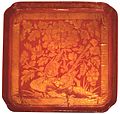Plik:Red lacquer tray with gold engraving, Song Dynasty.jpg
Wygląd

Rozmiar podglądu – 633 × 600 pikseli. Inne rozdzielczości: 253 × 240 pikseli | 507 × 480 pikseli | 811 × 768 pikseli | 1081 × 1024 pikseli | 2060 × 1952 pikseli.
Rozmiar pierwotny (2060 × 1952 pikseli, rozmiar pliku: 2,2 MB, typ MIME: image/jpeg)
Historia pliku
Kliknij na datę/czas, aby zobaczyć, jak plik wyglądał w tym czasie.
| Data i czas | Miniatura | Wymiary | Użytkownik | Opis | |
|---|---|---|---|---|---|
| aktualny | 11:43, 18 wrz 2008 |  | 2060 × 1952 (2,2 MB) | Yug | image improvements |
| 21:33, 30 cze 2008 |  | 3072 × 2304 (3,34 MB) | PericlesofAthens | {{Information |Description=A Chinese red lacquer tray over wood with engraved golden foil, from the Song Dynasty (960–1279 AD), dated 12th to early 13th century. In China, the gold-engraving technique is called ''qiangjin''. It has existed since rou |
Lokalne wykorzystanie pliku
Następujące strony korzystają z tego pliku:
Globalne wykorzystanie pliku
Ten plik jest wykorzystywany także w innych projektach wiki:
- Wykorzystanie na bo.wikipedia.org
- Wykorzystanie na en.wikipedia.org
- Wykorzystanie na fr.wikipedia.org
- Wykorzystanie na id.wikipedia.org
- Wykorzystanie na is.wikipedia.org
- Wykorzystanie na it.wikipedia.org
- Wykorzystanie na ml.wikipedia.org
- Wykorzystanie na nl.wikipedia.org
- Wykorzystanie na ro.wikipedia.org
- Wykorzystanie na ru.wikipedia.org
- Wykorzystanie na sk.wikipedia.org
- Wykorzystanie na th.wikipedia.org
- Wykorzystanie na uk.wikipedia.org
- Wykorzystanie na vi.wikipedia.org
- Wykorzystanie na zh.wikipedia.org


